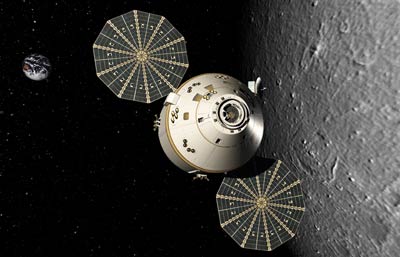Science and human exploration: together at lastby Jack Burns and Scott D. Norris
|
| On this first mission beyond LEO in over 40 years and the first human/robot exploration of the lunar farside, astronauts would return with a treasure trove of the oldest known rock samples that may hold the key to understanding the Earth-Moon formation. |
There are some intriguing opportunities that could allow NASA to begin these joint science and human explorations during this decade using rockets and capsules already in development. One particularly exciting and innovative scenario uses the Orion Multi-Purpose Crew Vehicle for pioneering explorations of the lunar farside. Orion could be launched this decade on a human-rated rocket to carry a crew of four to the Moon-Earth L-2 Lagrange point (which balances Earth and lunar gravitational forces), a location where Orion “hovers” above the farside but with Earth also in direct line of sight. This would be a first, placing humans farther than they have ever traveled from our home world (15 percent more distant than the Moon itself).
Preceding the Orion launch, an unmanned lander and rover would be sent to the Moon, touching down in the South Pole-Aitken Basin, one of deepest, oldest, and largest impact basins in the inner solar system—a top priority for scientific investigation in the recent National Research Council (NRC) Planetary Sciences Decadal Survey. The scientist-astronauts would teleoperate the rover from Orion, gaining much-needed experience in human-assisted robotic geological exploration that will be required for future missions to asteroids and Mars. The rover would also deploy the first low-frequency radio array on the radio-quiet farside; it would answer two of the top priority questions of the NRC Astrophysics Decadal Survey: “What were the first objects to light up the universe, and when did they do it?” The samples gathered by the rover would be launched from the surface, where Orion would rendezvous with this payload. Thus, on this first mission beyond LEO in over 40 years and the first human/robot exploration of the lunar farside, astronauts would return with a treasure trove of the oldest known rock samples that may hold the key to understanding the Earth-Moon formation.
A subsequent Orion mission could involve an Apollo-style sortie to the lunar surface using an affordable two-person lander, possibly developed and deployed with international collaboration. Butdidn’t we already do this in the 1960s? The difference is that new, remote-sensing observations of the Moon by spacecraft such as NASA’s Lunar Reconnaissance Orbiter (LRO) have revealed much more interesting and scientifically valuable locations to explore. For example, LRO recently found a lava tube at the bottom of a lunar crater. Astronauts could land in this crater and explore, using a human/robot tandem, geological features never before seen on an extraterrestrial body. Ancient lunar volcanism is important to understanding both the Earth’s and the Moon’s evolution. Equally valuable is that these lava tubes would be ideal sites to house and shield astronauts from solar and galactic radiation while they learn to live and work on another nearby world before much longer and more dangerous missions to asteroids and to Mars. Imagine real-time, high-definition video coming back to Earth as the astronauts explore these dark, expansive caverns cut millions of years ago by flowing volcanic magma. This is the ultimate in reality television!
| Joint science and human exploration, making use of new capabilities for telerobotics, is an exciting vision for NASA’s near future. |
Another intriguing and important location for a sortie mission would be the lunar poles, where permanently-shadowed craters are now known to house substantial amounts of water ice. Exploring these craters, which are possibly the coldest regions in the solar system, with robots and learning how to mine water ice would be firsts in the space program.
With the valuable lessons learned from these orbit and surface explorations of the Moon, we might begin to move more sure-footedly into the solar system. Using these lunar missions, we would hope to learn more about the space radiation environment beyond LEO and develop and test shielding for spacecraft that will be a prerequisite for venturing beyond the Moon. The next missions could involve longer, six- to nine-month operations to near Earth objects, such as the recently discovered Trojan asteroids that share Earth’s orbit. Not only would such a mission allow significant scientific research, but it also would validate the technologies and techniques required when approaching the moons of Mars and other planets. Then, with risks reduced, a human orbital mission around Mars may be possible.
This steppingstone approach to human exploration of the solar system, beginning with the Moon-Earth environment, is safe but also extremely interesting from a science perspective. Joint science and human exploration, making use of new capabilities for telerobotics, is an exciting vision for NASA’s near future.
